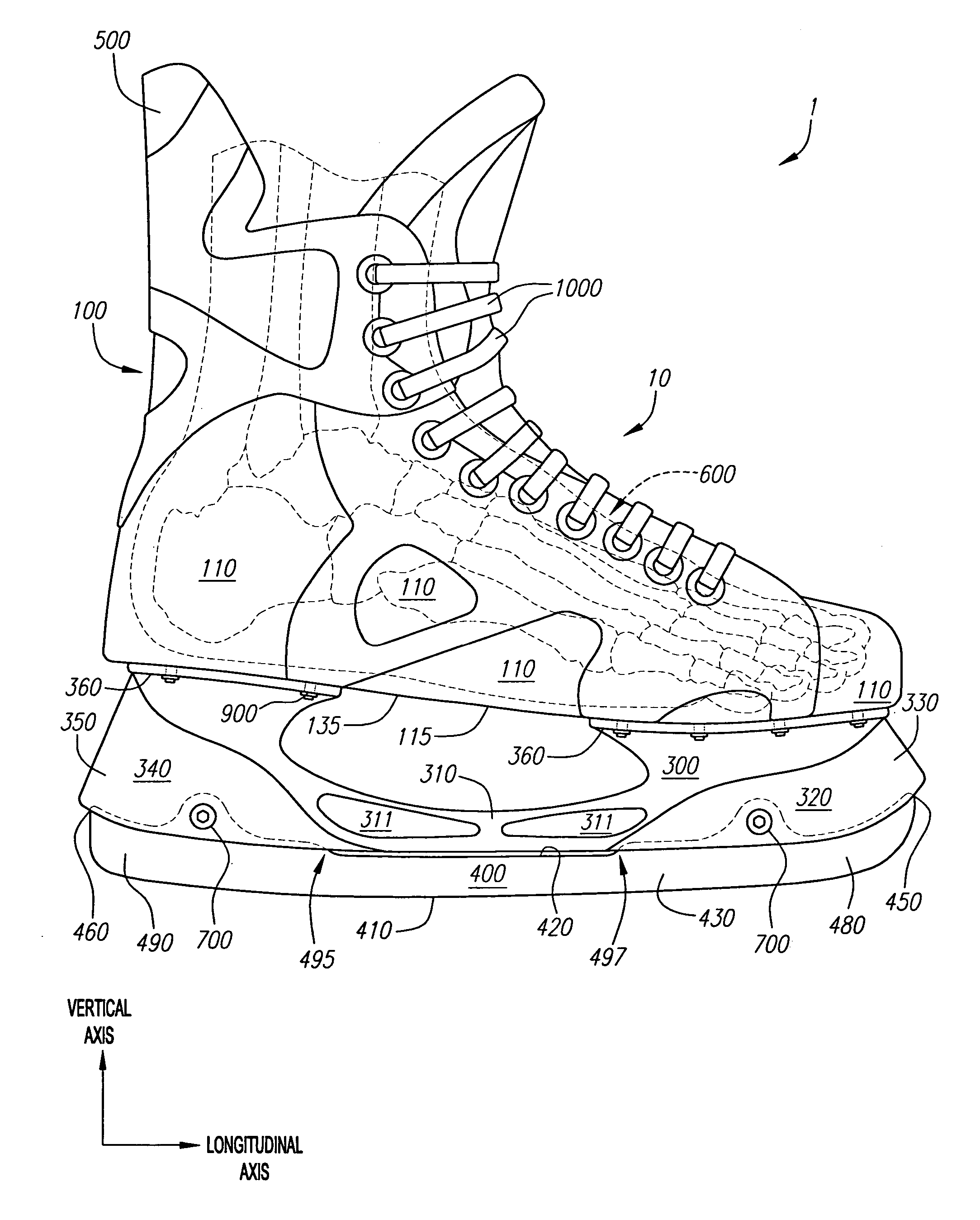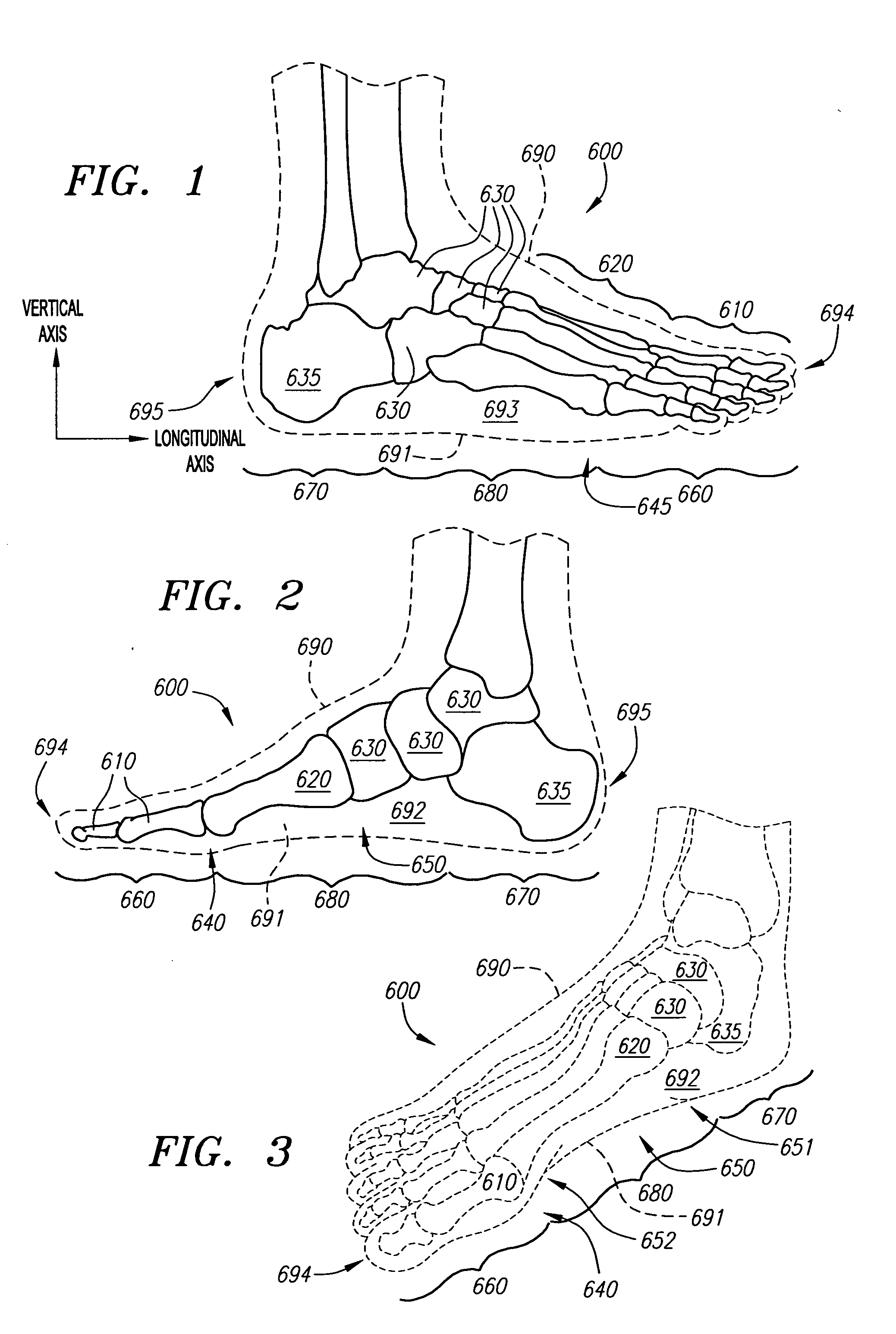Article of footwear comprising a unitary support structure and method of manufacture
a unitary support and footwear technology, applied in the field of footwear, can solve the problems of time and labor, increased cost of an already expensive process, and inability to meet the requirements of quality assurance measures, and achieve the effect of avoiding the necessity of quality assurance measures and reducing the cost of manufacturing
- Summary
- Abstract
- Description
- Claims
- Application Information
AI Technical Summary
Benefits of technology
Problems solved by technology
Method used
Image
Examples
example application no.1
Example Application No. 1 of Formulas (1) through (3)
[0172] Suppose that L-HB measures eight (8 ) inches then the PLR, MPLR, and EMPLR according to formulas (1) through (3), as previously set forth, are:
L-HBPLRMPLREMPLR8 inches+ / −2.4 inches+ / −1.2 inches+ / −0.6 inches
[0173] Vis-à-vis terminal end points 166 and 182 and longitudinal partitions 161, each of those preferred longitudinal location ranges is centered at the anterior end 651 of the heel region 670. Accordingly, taking the longitudinal length of heel region 670 as constituting 40% of the L-HB then the anterior end 651 of the heel region 670 would be located 3.2 inches (40% of 8 inches) anterior from the back of the heel region 670. The preferred longitudinal location of terminal end point 166 and 182 and longitudinal partitions 161 would thus be:
Anterior End ofAnterior End ofAnterior End ofHeel + / − PLRHeel + / − MPLRHeel + / − EMPLR3.2 inches + / − 2.4 inches3.2 inches + / − 1.2 inches3.2 inches + / − 0.6inches
[0174] In order to fu...
example application no.2
Example Application No. 2 of Formulas (1) through (3)
[0179] Suppose again that L-HB measures eight (8) inches. The PLR, MPLR, and EMPLR, according to formulas (1) through (3), would thus be the same as previously set forth in Example Application No. 1. The preferred longitudinal location of terminal end points 167 and 181 and longitudinal partitions 162 vis-à-vis the ball of the foot 640 would thus be:
Ball of theBall of the Foot + / − PLRBall of the Foot + / − MPLRFoot + / − EMPLR8 inches + / − 2.4 inches8 inches + / − 1.2 inches8 inches + / − 0.6inches
[0180] With reference to FIG. 26 the longitudinal center of the ranges PLR, MPLR, and EMPLR on the medial and lateral sides 140, 150 of the sole 115 would be centered on horizontal axis line 1110, which as previously described corresponds with the ball of the foot 640 and the lateral extent of the foot 645. Accordingly, by way of example, if terminal end point 167 or 181 is located on the unitary support structure 110 between 5.6 inches and 10....
PUM
| Property | Measurement | Unit |
|---|---|---|
| longitudinal length | aaaaa | aaaaa |
| longitudinal length | aaaaa | aaaaa |
| distance | aaaaa | aaaaa |
Abstract
Description
Claims
Application Information
 Login to View More
Login to View More - R&D
- Intellectual Property
- Life Sciences
- Materials
- Tech Scout
- Unparalleled Data Quality
- Higher Quality Content
- 60% Fewer Hallucinations
Browse by: Latest US Patents, China's latest patents, Technical Efficacy Thesaurus, Application Domain, Technology Topic, Popular Technical Reports.
© 2025 PatSnap. All rights reserved.Legal|Privacy policy|Modern Slavery Act Transparency Statement|Sitemap|About US| Contact US: help@patsnap.com



